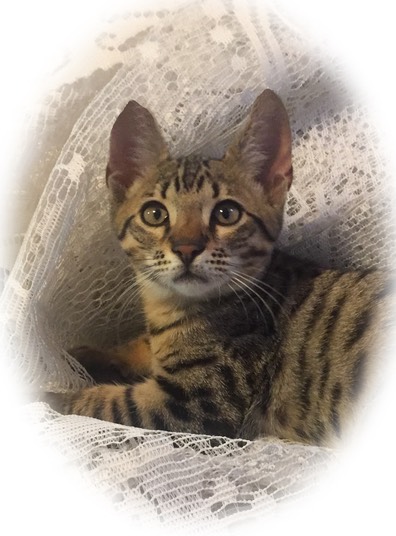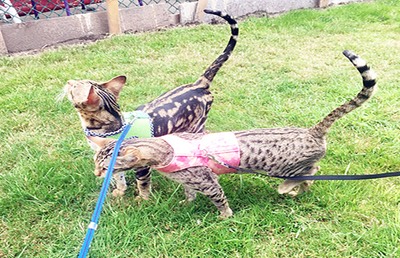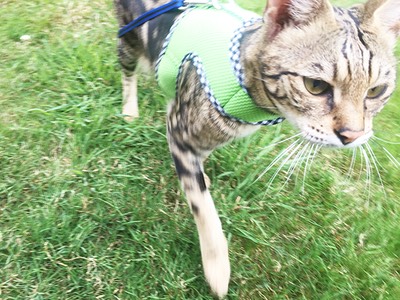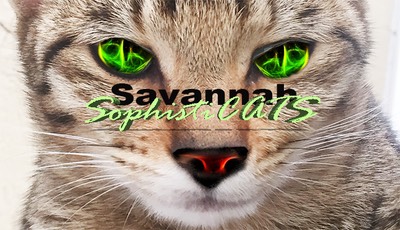At Savannah SophistiCATS our goal to produce very high quality, beautifully cute kittens. We have a variety of purebreds, from F2 to F5, with the occasional mixed breed (we have done inter-breeding with Siamese in an attempt to get Blue Eyed Savannahs).
All our Savannah kittens are properly socialized, vaccinated, de-wormed, litter trained and come with one month health insurance (Trupanion). They can be microchipped, or spayed or neutered prior to shipping (additional cost). In addition, older kittens have experience walking on a leash.
Process
Once decision is made as to ownership being house pet or breeder cat, and full payment is received, the new TICA registration and ownership papers will be ordered, paid for by us and sent to you from the TICA the Internation Cat Association. It takes about 6 weeks.
What are Savannah Cats?

Savannah cats are a spotted breed of domestic cat, with an elegantly tall, slender legs, and long body frame. The savannah breed originates from a serval bred with a domestic cat.
A serval is a small species of wild cat native to the African plains (or ‘savannah’, hence the breed’s name). The first generation of savannah cats are referred to as ‘F1’ for first generation, and if they are from a 100% domestic mother they are exactly 50% serval. If a serval is bred to a savannah female, then depending on what generation savannah the female is they will produce F1 kittens greater than 50%. A 50% F1 female bred to a savannah male produces F2 kittens that are ~ 27-30% serval (depending on how many generations of savannahs are in the stud’s pedigree). Similarly, an F2 savannah female produces F3 kittens that may be ~ 14-18% serval or more. It gets more and more difficult to estimate the % serval the more generations away one gets from the serval ancestor; it depends on how many savannah studs are in the pedigree, and what their genetic background is. In F4 and later generation cats with multiple savannahs on both sides of the pedigree, you cannot calculate the theoretical serval % with any accuracy. F4 savannahs could theoretically be 7% serval or they could be much more, but the exact amount is impossible to say because of the way inheritance works, as I explain next.
Savannah Genetics 101.

African and North American cat species (and domestic cats, which originated from African Wildcats, Felis silvestris), have 19 different kinds of chromosomes, with 2 of each kind (having 2 sets of chromosomes is referred to as ‘diploid’ by biologists). So each of their body cells contains 19 pairs or 38 chromosomes total (humans have 23 pairs for a total of 46). A sperm and an egg each contain one set of 19 chromosomes (1 of each kind, thus sperm and eggs are ‘haploid’). When a sperm fertilizes an egg, the newly formed zygote and subsequent embryo cells thus again have two sets of 19 for a total of 38 chromosomes. When that offspring grows up and produces sperm or eggs themselves, the genes from their parents are first mixed together; the 2 chromosomes of each kind twist together and swap genes – a process called crossover. Thus, in the eggs produced by an F1 savannah, crossover results in each chromosome having an unpredictable combination of some serval genes and some domestic genes. Then the pairs of chromosomes are split up and 19 of each is sorted into a gamete in a random way. So the chromosomes that end up in a particular gamete may have more or less serval genes than the chromosomes put in another gamete…it is totally unpredictable. Just a few generations of this, and you can see how totally mixed up the serval and domestic genes become. There is just NO way of calculating a serval % for these cats, and it is really only a rough estimate in the F2 and F3 generations.

But the objective of a savannah breeding program is NOT to concentrate serval genes (we really do not want to recreate a serval), but to produce a DOMESTIC cat that resembles a serval and has the positive personality traits of both servals and domestic cats.
Because savannahs are produced by breeding two different species of cats together (serval X domestic), the male offspring are usually sterile for the first 4 generations. When the breed was started, domestic males of different breeds were bred to savannah females. After several years of developing the breed however, fertile male savannahs (usually F5, F6, or F7 generations) are now common in most breeding programs.
TICA Codes
When a savannah is registered with TICA, they are assigned a registration code that roughly indicates the number of savannah to savannah breedings behind that cat. A savannah female bred to a domestic male or a serval male always has an ‘A’ code because they do not have a savannah parent on both sides.
A savannah with a B code is the result of a ‘A’ savannah bred to another savannah.
SBT (which is a TICA acronym for ‘stud book traditional’).
An SBT savannah thus has a minimum of 3 generations of savannah to savannah breeding in their pedigree. As of this update (July 2016), many F4-F7 savannahs at are at the SBT level. Savannahs that are F1-F3 cannot be SBT because they are close to the serval.
An F1 can only be A because they have a serval parent. But F2 savannahs can be an A or a B, and an F3 savannah can be A, B or C.
The goal of the savannah breed is to develop a domestic breed of cat that has the beauty and positive personality traits of a serval, but in a domestic cat that makes a wonderful pet.
